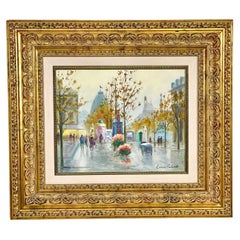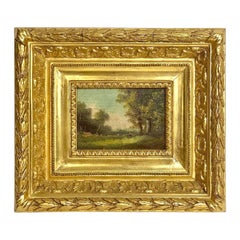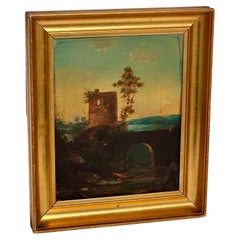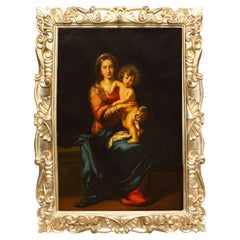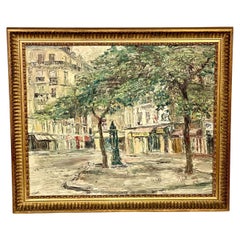Gilt Paintings
1790s Greek Neoclassical Antique Gilt Paintings
Gold Leaf
Mid-20th Century French Gilt Paintings
Canvas, Giltwood, Paint
Late 19th Century French Antique Gilt Paintings
Giltwood, Paint
Late 19th Century French Romantic Antique Gilt Paintings
Canvas, Wood, Giltwood, Paint
1910s Italian Baroque Vintage Gilt Paintings
Canvas, Giltwood
20th Century French Gilt Paintings
Canvas, Giltwood, Paint
20th Century Spanish Rococo Gilt Paintings
Gold Leaf
20th Century French Modern Gilt Paintings
Canvas, Wood, Paint
19th Century English Victorian Antique Gilt Paintings
Canvas, Wood, Paint
17th Century Italian Baroque Antique Gilt Paintings
Gold Leaf
Early 20th Century English Edwardian Gilt Paintings
Canvas, Wood
Late 18th Century Swedish Rococo Antique Gilt Paintings
Canvas, Wood
Mid-20th Century American Mid-Century Modern Gilt Paintings
Paint, Wood
20th Century Chinese Chinese Export Gilt Paintings
Soapstone, Brass
19th Century Italian Baroque Antique Gilt Paintings
Canvas, Giltwood
Early 20th Century English Gilt Paintings
Canvas, Wood
1890s Italian Gothic Revival Antique Gilt Paintings
Oak, Paint, Wood
Late 19th Century Austrian Antique Gilt Paintings
Canvas, Wood, Giltwood, Paint
Late 19th Century English Antique Gilt Paintings
Wood, Paint
Early 20th Century British Gilt Paintings
Canvas, Glass, Wood, Giltwood, Paint
Mid-20th Century French Gilt Paintings
Giltwood, Canvas
1950s Peruvian Vintage Gilt Paintings
Wood
Early 19th Century European Gothic Revival Antique Gilt Paintings
Iron, Zinc
Early 1800s Italian Renaissance Antique Gilt Paintings
Wood, Gesso, Canvas
Late 19th Century English Victorian Antique Gilt Paintings
Wood, Giltwood, Paint
20th Century Italian Chinoiserie Gilt Paintings
Wood
19th Century French Rococo Revival Antique Gilt Paintings
Canvas, Giltwood
20th Century French Gilt Paintings
Canvas, Giltwood
Early 20th Century American Gilt Paintings
Giltwood, Canvas
Late 19th Century German Baroque Antique Gilt Paintings
Gesso, Canvas, Wood
1840s American American Empire Antique Gilt Paintings
Gesso, Canvas, Wood, Giltwood, Paint
Late 19th Century Belgian Antique Gilt Paintings
Canvas, Giltwood
17th Century Peruvian Antique Gilt Paintings
Wood, Paint, Giltwood
19th Century French Rococo Antique Gilt Paintings
Masonite, Gesso, Canvas, Giltwood
19th Century American Victorian Antique Gilt Paintings
Rosewood
Early 19th Century French Louis XV Antique Gilt Paintings
Canvas, Giltwood
19th Century Chinese Ming Antique Gilt Paintings
Silk, Wood, Paint
Late 19th Century Belgian Antique Gilt Paintings
Giltwood
Late 19th Century Danish Romantic Antique Gilt Paintings
Canvas, Wood
Late 19th Century French Antique Gilt Paintings
Giltwood
Late 19th Century English Antique Gilt Paintings
Canvas, Giltwood
19th Century French Napoleon III Antique Gilt Paintings
Wood
Early 19th Century Italian Empire Antique Gilt Paintings
Canvas, Wood, Paint
20th Century Italian Mid-Century Modern Gilt Paintings
Wood
Late 18th Century French Chinoiserie Antique Gilt Paintings
Canvas, Giltwood
Early 1900s French Romantic Antique Gilt Paintings
Wood, Paint
Mid-20th Century French Mid-Century Modern Gilt Paintings
Canvas, Wood
19th Century English Antique Gilt Paintings
Canvas
1880s Antique Gilt Paintings
Bronze
Late 19th Century German Rococo Revival Antique Gilt Paintings
Canvas, Wood
Mid-19th Century Italian Neoclassical Antique Gilt Paintings
Canvas, Giltwood
19th Century French Antique Gilt Paintings
Giltwood, Paint
1890s German Belle Époque Antique Gilt Paintings
Porcelain, Giltwood
1980s French Vintage Gilt Paintings
Canvas, Wood, Paint
Late 19th Century German Renaissance Antique Gilt Paintings
Porcelain, Wood
Late 19th Century French Romantic Antique Gilt Paintings
Canvas, Wood, Plywood
Mid-19th Century Italian Antique Gilt Paintings
Canvas, Wood, Paint
1820s Russian Revival Antique Gilt Paintings
Wood, Paint
Early 18th Century Italian Baroque Antique Gilt Paintings
Canvas, Wood
Late 19th Century Russian Beaux Arts Antique Gilt Paintings
Wood, Giltwood, Paint
